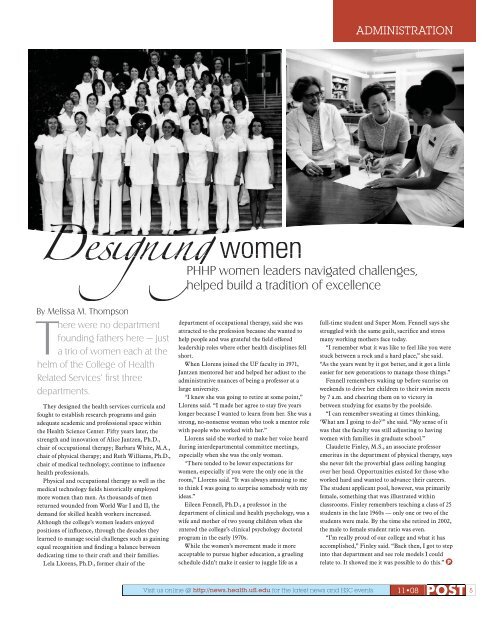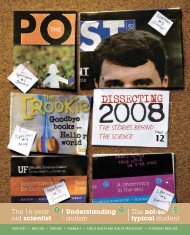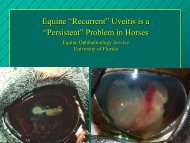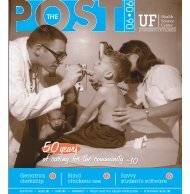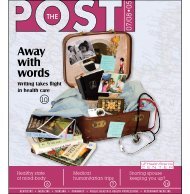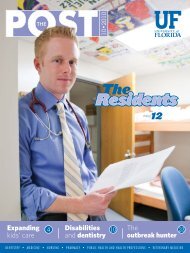POST - UF Health Podcasts - University of Florida
POST - UF Health Podcasts - University of Florida
POST - UF Health Podcasts - University of Florida
You also want an ePaper? Increase the reach of your titles
YUMPU automatically turns print PDFs into web optimized ePapers that Google loves.
ADMINISTRATIONDesigningwomenPHHP women leaders navigated challenges,helped build a tradition <strong>of</strong> excellenceBy Melissa M. ThompsonThere were no departmentfounding fathers here — justa trio <strong>of</strong> women each at thehelm <strong>of</strong> the College <strong>of</strong> <strong>Health</strong>Related Services’ fi rst threedepartments.They designed the health services curricula andfought to establish research programs and gainadequate academic and pr<strong>of</strong>essional space withinthe <strong>Health</strong> Science Center. Fifty years later, thestrength and innovation <strong>of</strong> Alice Jantzen, Ph.D.,chair <strong>of</strong> occupational therapy; Barbara White, M.A.,chair <strong>of</strong> physical therapy; and Ruth Williams, Ph.D.,chair <strong>of</strong> medical technology; continue to influencehealth pr<strong>of</strong>essionals.Physical and occupational therapy as well as themedical technology fields historically employedmore women than men. As thousands <strong>of</strong> menreturned wounded from World War I and II, thedemand for skilled health workers increased.Although the college’s women leaders enjoyedpositions <strong>of</strong> influence, through the decades theylearned to manage social challenges such as gainingequal recognition and finding a balance betweendedicating time to their craft and their families.Lela Llorens, Ph.D., former chair <strong>of</strong> thedepartment <strong>of</strong> occupational therapy, said she wasattracted to the pr<strong>of</strong>ession because she wanted tohelp people and was grateful the field <strong>of</strong>feredleadership roles where other health disciplines fellshort.When Llorens joined the <strong>UF</strong> faculty in 1971,Jantzen mentored her and helped her adjust to theadministrative nuances <strong>of</strong> being a pr<strong>of</strong>essor at alarge university.“I knew she was going to retire at some point,”Llorens said. “I made her agree to stay five yearslonger because I wanted to learn from her. She was astrong, no-nonsense woman who took a mentor rolewith people who worked with her.”Llorens said she worked to make her voice heardduring interdepartmental committee meetings,especially when she was the only woman.“There tended to be lower expectations forwomen, especially if you were the only one in theroom,” Llorens said. “It was always amusing to meto think I was going to surprise somebody with myideas.”Eileen Fennell, Ph.D., a pr<strong>of</strong>essor in thedepartment <strong>of</strong> clinical and health psychology, was awife and mother <strong>of</strong> two young children when sheentered the college’s clinical psychology doctoralprogram in the early 1970s.While the women’s movement made it moreacceptable to pursue higher education, a gruelingschedule didn’t make it easier to juggle life as afull-time student and Super Mom. Fennell says shestruggled with the same guilt, sacrifice and stressmany working mothers face today.“I remember what it was like to feel like you werestuck between a rock and a hard place,” she said.“As the years went by it got better, and it got a littleeasier for new generations to manage those things.”Fennell remembers waking up before sunrise onweekends to drive her children to their swim meetsby 7 a.m. and cheering them on to victory inbetween studying for exams by the poolside.“I can remember sweating at times thinking,‘What am I going to do?’” she said. “My sense <strong>of</strong> itwas that the faculty was still adjusting to havingwomen with families in graduate school.”Claudette Finley, M.S., an associate pr<strong>of</strong>essoremeritus in the department <strong>of</strong> physical therapy, saysshe never felt the proverbial glass ceiling hangingover her head. Opportunities existed for those whoworked hard and wanted to advance their careers.The student applicant pool, however, was primarilyfemale, something that was illustrated withinclassrooms. Finley remembers teaching a class <strong>of</strong> 25students in the late 1960s — only one or two <strong>of</strong> thestudents were male. By the time she retired in 2002,the male to female student ratio was even.“I’m really proud <strong>of</strong> our college and what it hasaccomplished,” Finley said. “Back then, I got to stepinto that department and see role models I couldrelate to. It showed me it was possible to do this.” PVisit us online @ http://news.health.ufl.edu for the latest news and HSC events. 11•08<strong>POST</strong>5


